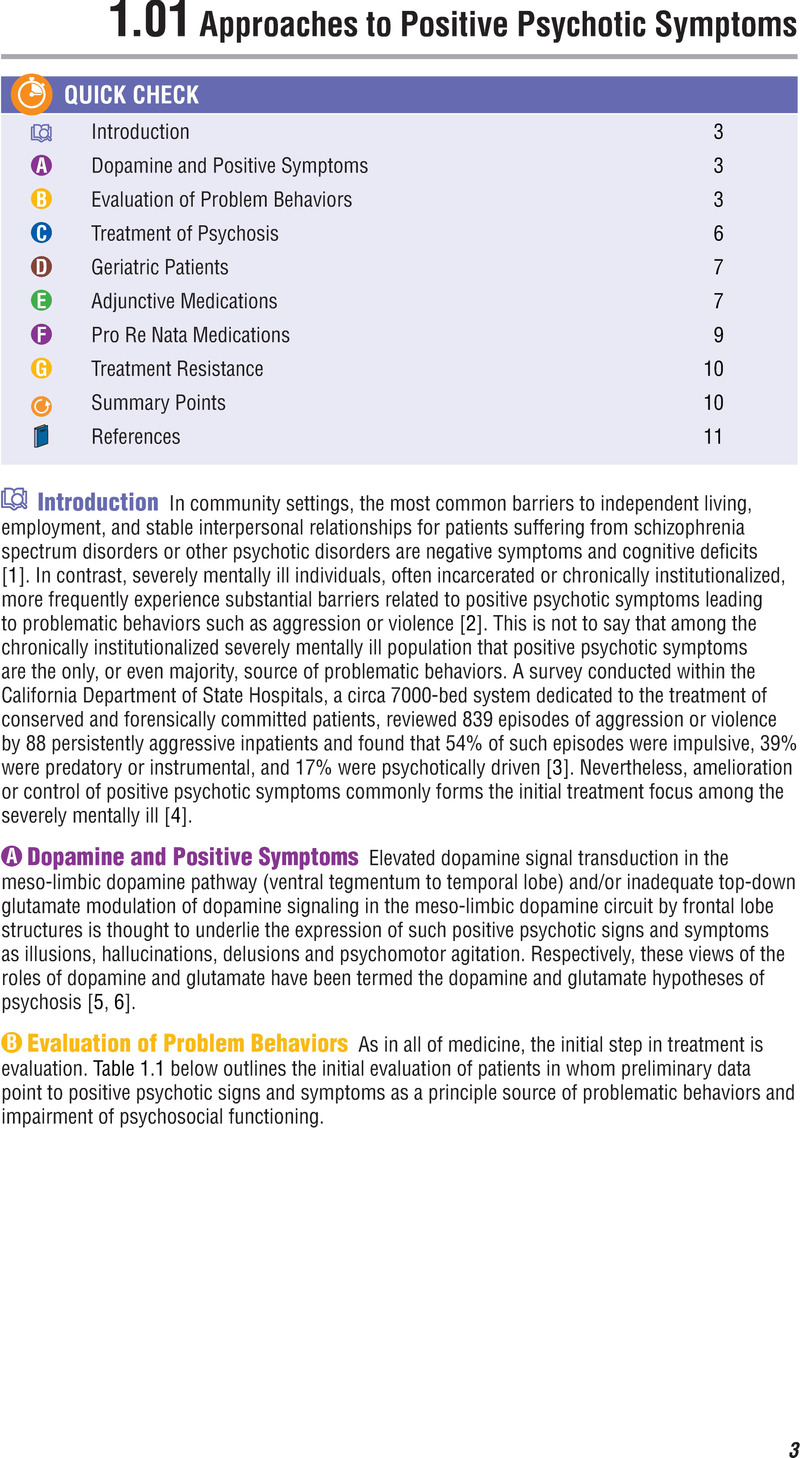Book contents
- Management of Complex Treatment-Resistant Psychotic Disorders
- Management of Complex Treatment-Resistant Psychotic Disorders
- Copyright page
- Contents
- Contributors
- Acknowledgements
- Abbreviations
- List of Icons
- Introduction
- Part I Treatment Strategies
- 1.01 Approaches to Positive Psychotic Symptoms
- Introduction
- A Dopamine and Positive Symptoms
- B Evaluation of Problem Behaviors
- C Treatment of Psychosis
- D Geriatric Patients
- E Adjunctive Medications
- F Pro Re Nata Medications
- G Treatment Resistance
- Summary Points
- Quick check
- 1.02 Use of Plasma Levels in Antipsychotic and Mood Stabilizer Treatment
- 1.03 Advantages of Long-Acting Injectable Antipsychotics
- 1.04 Approach to Treatment-Resistant Schizophrenia Spectrum Patients
- 1.05 Approach to Depressed or Suicidal Schizophrenia Spectrum Patients
- 1.06 Approach to Persistent Aggression and Violence in Schizophrenia Spectrum Psychotic Disorders
- 1.07 Approach to Bipolar Diathesis in Schizophrenia Spectrum Patients
- 1.08 Approach to Anxiety in Schizophrenia Spectrum Patients
- 1.09 Approach to Insomnia and Sleep Disturbance in Schizophrenia Spectrum Disorders
- 1.10 Approach to Psychosis in Children and Adolescents
- 1.11 Electroconvulsive Therapy and Other Non-Pharmacological Treatments
- 1.12 Approach to Substance Use Disorders in Schizophrenia Spectrum Disorders
- 1.13 Approaches to Behavioral Disturbances in Dementia and Traumatic Brain Injury Patients
- Part II Medication Reference Tables
- Appendices
- Index
Quick check
from 1.01 - Approaches to Positive Psychotic Symptoms
Published online by Cambridge University Press: 19 October 2021
- Management of Complex Treatment-Resistant Psychotic Disorders
- Management of Complex Treatment-Resistant Psychotic Disorders
- Copyright page
- Contents
- Contributors
- Acknowledgements
- Abbreviations
- List of Icons
- Introduction
- Part I Treatment Strategies
- 1.01 Approaches to Positive Psychotic Symptoms
- Introduction
- A Dopamine and Positive Symptoms
- B Evaluation of Problem Behaviors
- C Treatment of Psychosis
- D Geriatric Patients
- E Adjunctive Medications
- F Pro Re Nata Medications
- G Treatment Resistance
- Summary Points
- Quick check
- 1.02 Use of Plasma Levels in Antipsychotic and Mood Stabilizer Treatment
- 1.03 Advantages of Long-Acting Injectable Antipsychotics
- 1.04 Approach to Treatment-Resistant Schizophrenia Spectrum Patients
- 1.05 Approach to Depressed or Suicidal Schizophrenia Spectrum Patients
- 1.06 Approach to Persistent Aggression and Violence in Schizophrenia Spectrum Psychotic Disorders
- 1.07 Approach to Bipolar Diathesis in Schizophrenia Spectrum Patients
- 1.08 Approach to Anxiety in Schizophrenia Spectrum Patients
- 1.09 Approach to Insomnia and Sleep Disturbance in Schizophrenia Spectrum Disorders
- 1.10 Approach to Psychosis in Children and Adolescents
- 1.11 Electroconvulsive Therapy and Other Non-Pharmacological Treatments
- 1.12 Approach to Substance Use Disorders in Schizophrenia Spectrum Disorders
- 1.13 Approaches to Behavioral Disturbances in Dementia and Traumatic Brain Injury Patients
- Part II Medication Reference Tables
- Appendices
- Index
Summary

- Type
- Chapter
- Information
- Publisher: Cambridge University PressPrint publication year: 2021

